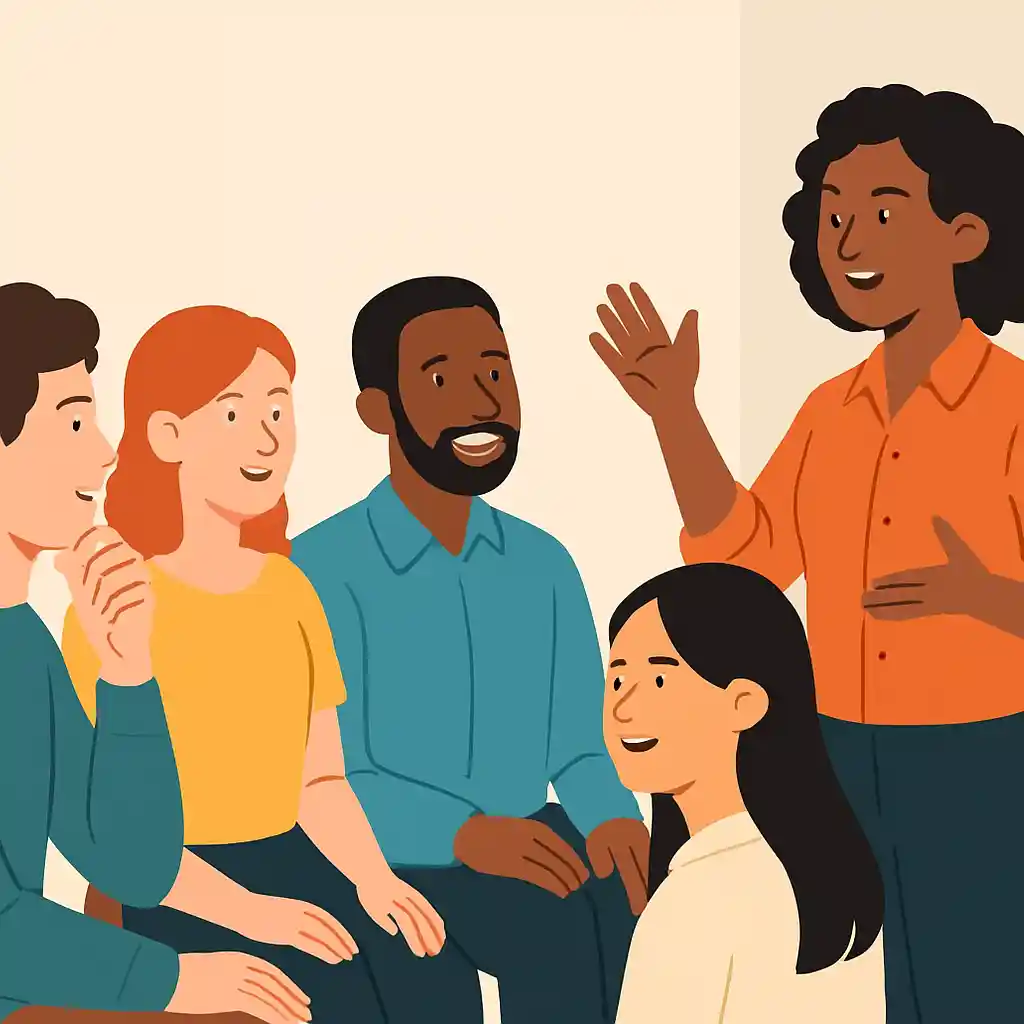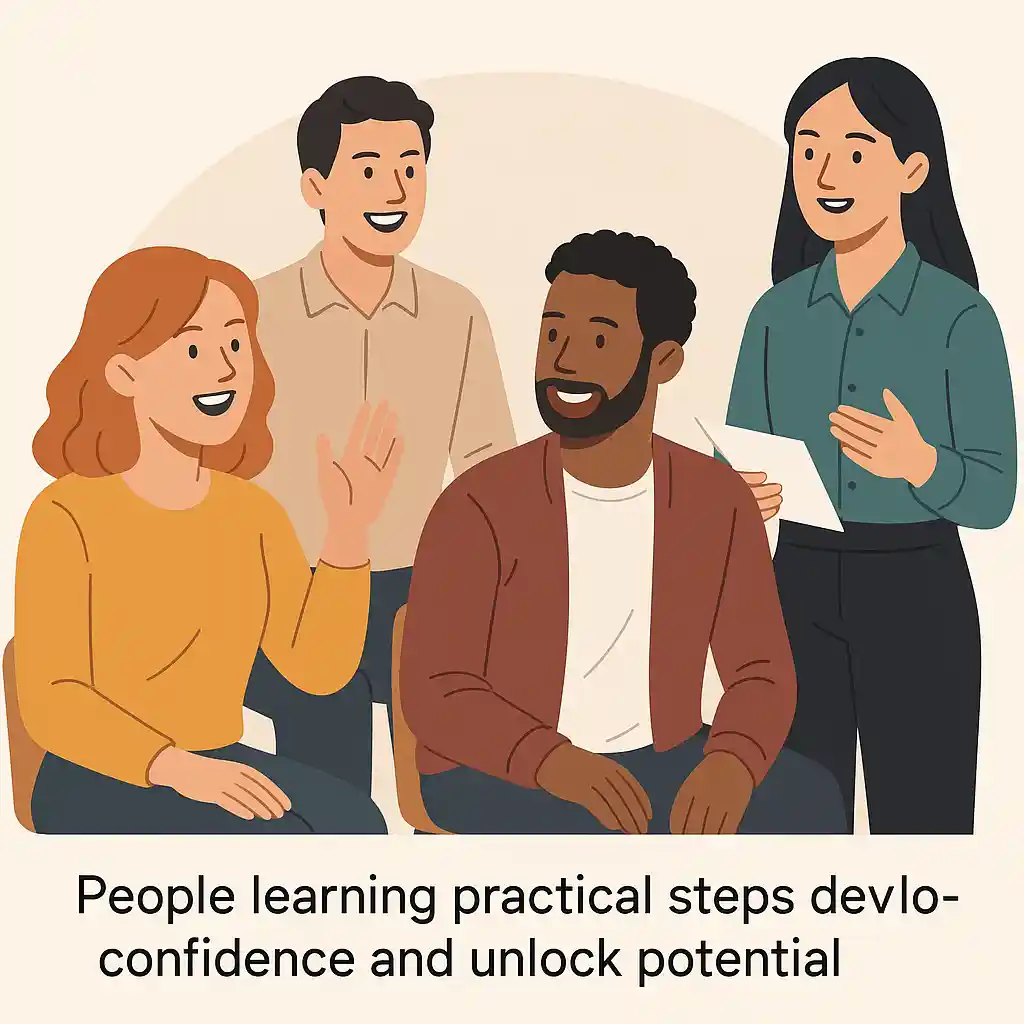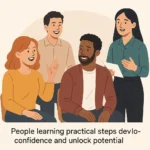How to Develop Confidence: Your Step-by-Step Action Plan
Ever feel that nagging voice of self-doubt whispering that you’re not good enough? Maybe it stops you from speaking up in meetings, pursuing a passion project, or even just feeling comfortable in your own skin. You see others moving forward, seemingly fearless, and wonder, “How do they do it?” The good news is, confidence isn’t some magical trait you’re either born with or not. It’s a skill. And like any skill, you absolutely can develop confidence with the right mindset and consistent practice. This guide isn’t about quick fixes or empty affirmations; it’s packed with actionable strategies, insights into the psychology of self-belief, and practical steps you can start taking today to build genuine, resilient confidence from the ground up. Get ready to step out of the shadows and into your potential.
Table of Contents
What Really Is Confidence (And What It Isn’t)?
Before we dive into how to build it, let’s clear up what confidence truly means. It’s often confused with arrogance or loudness, but genuine confidence is quieter, more internal.
- It’s Trust: Confidence is fundamentally about trusting yourself – trusting your judgment, your abilities, and your resilience to handle whatever comes your way. It’s the belief that you can figure things out, learn, adapt, and cope.
- It’s Action-Oriented: Confident people aren’t necessarily fearless, but they act despite their fear. They’re willing to try, knowing that failure is a possibility but not a definition of their worth.
- It’s Realistic: True confidence acknowledges weaknesses and areas for growth without letting them paralyze action. It’s rooted in self-awareness, not delusion.
Defining Self-Confidence vs. Arrogance
It’s a crucial distinction.
- Self-Confidence: Comes from a place of internal validation and self-awareness. It allows for humility, listening to others, and admitting mistakes. It’s about feeling secure in your own abilities.
- Arrogance: Often stems from insecurity and needs external validation. It manifests as boasting, dismissing others, and an inability to accept criticism. It’s about projecting superiority over others.
Our goal here is to cultivate that authentic self-trust, not a brittle facade.

Why Developing Confidence is Crucial for Your Life
Think about it – confidence impacts nearly every area of your existence:
- Career: Asking for a raise, leading a project, networking effectively, handling interviews.
- Relationships: Setting healthy boundaries, expressing needs clearly, feeling secure in partnerships.
- Personal Growth: Trying new hobbies, traveling solo, overcoming setbacks, pursuing goals.
- Well-being: Reduced anxiety, better stress management, increased resilience, greater overall happiness.
Low confidence acts like an invisible barrier, limiting your experiences and opportunities. Developing it unlocks doors you might not even realize are closed right now.
The Mind-Body Connection: How Your Thoughts Shape Your Reality
Confidence isn’t just “in your head”; it’s deeply intertwined with your physiology and psychology. What you think directly influences how you feel and act.
Think about a time you felt truly unsure of yourself. What was your body doing? Slumped shoulders? Averted gaze? Shallow breathing? Now picture someone confident. They likely stand taller, make eye contact, and occupy their space. This isn’t just coincidence.
Neuroplasticity: Can You Rewire Your Brain for Confidence?
Absolutely! One of the most exciting discoveries in neuroscience is neuroplasticity – the brain’s ability to reorganize itself by forming new neural connections 1 throughout life. This means your 2 habitual thought patterns (like negative self-talk) aren’t set in stone.
Every time you challenge a limiting belief, try something new, or practice a confidence-building technique, you are literally forging new pathways in your brain. Consistent effort reinforces these pathways, making confident thoughts and behaviours feel more natural over time. It’s like carving a new trail through a dense forest – hard at first, but easier with each pass. (For more on how the brain adapts, general neuroscience resources from reputable institutions like the National Institute of Mental Health (https://www.nimh.nih.gov) offer insights into brain function and plasticity).
The Role of Past Experiences and Beliefs
Our current confidence levels are often shaped by our past. Early experiences, feedback from caregivers or teachers, past failures, or critical comments can create core beliefs about ourselves (e.g., “I’m not smart enough,” “I always mess things up”). These beliefs, often operating subconsciously, filter how we interpret present situations and predict future outcomes, reinforcing cycles of self-doubt. Recognizing these roots is the first step toward challenging and changing them.
Recognizing the Roadblocks: What’s Holding You Back from Developing Confidence?
To build something new, you first need to clear the obstacles. What commonly gets in the way of developing confidence?
- Fear of Failure and Perfectionism: The intense fear of messing up or not meeting impossibly high standards can be paralyzing. Perfectionism whispers that if you can’t do it perfectly, you shouldn’t do it at all, preventing you from taking the very actions that build confidence.
- Negative Self-Talk and the Inner Critic: That relentless internal commentary pointing out flaws, predicting disaster, and replaying past mistakes. This inner critic erodes self-belief and makes it incredibly hard to feel capable.
- Comparison and Social Media Traps: Constantly comparing your ‘behind-the-scenes’ reality to others’ curated ‘highlight reels’ (especially online) is a recipe for feeling inadequate. It shifts your focus from your own progress to perceived shortcomings relative to others.
- Imposter Syndrome: Feeling Like a Fraud: The persistent feeling that you’re going to be “found out” as incompetent, despite evidence of your accomplishments. It makes you discount your successes and attribute them to luck or circumstance.
Do any of these sound familiar? Identifying your specific roadblocks is key to choosing the right strategies to overcome them.
Building Your Confidence Toolkit: Practical Steps You Can Start Today
Okay, let’s get to the core – the actionable strategies. Remember, consistency is key. Pick one or two that resonate most and commit to practicing them to Develop Confidence.
Step 1: Challenge Negative Thoughts (Cognitive Restructuring)
Your inner critic isn’t telling the truth; it’s voicing fears and learned negativity. Learn to question it:
- Catch it: Become aware of when negative thoughts pop up. Write them down.
- Challenge it: Ask yourself: Is this thought 100% true? What’s the evidence against it? What’s a more balanced, realistic perspective? Is this thought helpful?
- Change it: Reframe the thought into something more constructive and realistic. Instead of “I’m going to fail this presentation,” try “I’m prepared, I know the material, and I can handle questions. It’s okay to be nervous.”
Step 2: Set Small, Achievable Goals (Build Momentum)
Confidence grows from competence. Aiming too high too soon sets you up for failure. Instead, break larger goals into tiny, manageable steps.
- Example: If “develop confidence in speaking” is the goal, start small:
- Week 1: Speak up once in a low-stakes meeting.
- Week 2: Ask a question in a larger group.
- Week 3: Volunteer to present one slide.
- Each small win builds evidence for your brain that you can do things, creating a positive feedback loop.
Step 3: Practice Self-Compassion (Be Kind to Yourself)
Treat yourself with the same kindness and understanding you’d offer a good friend facing a setback. Confidence isn’t about never failing; it’s about how you treat yourself when you do.
- Acknowledge suffering: “This is hard right now.”
- Common humanity: “Everyone struggles sometimes; I’m not alone in this.”
- Be kind: Offer yourself words of comfort and encouragement, not harsh criticism.
- Dr. Kristin Neff is a leading researcher in this field; exploring resources on self-compassion can provide deeper understanding and techniques (https://self-compassion.org/ is a great starting point).
Step 4: Master Your Body Language (Power Posing & Presence)
How you hold yourself physically impacts how you feel mentally (and how others perceive you).
- Stand tall: Shoulders back, head up. Avoid slouching.
- Make eye contact: It conveys engagement and self-assuredness.
- Use open gestures: Avoid crossing arms or hiding hands.
- “Power Posing”: Research suggests that adopting expansive postures (like standing tall with hands on hips) for even a couple of minutes can temporarily boost feelings of confidence and reduce stress hormones. While the science is debated on long-term effects, it can be a helpful tool before a nerve-wracking event. Consider Amy Cuddy’s work on presence for more on this mind-body link.
Step 5: Embrace Lifelong Learning (Skill Development)
Feeling incompetent often stems from a genuine skill gap. Identify areas where you feel lacking and proactively work on improving.
- Take a course.
- Read books or articles.
- Find a mentor.
- Practice deliberately. The act of learning and improving itself is a massive confidence booster. You’re proving to yourself that you can grow and adapt.
Step 6: Step Outside Your Comfort Zone (Calculated Risks)
Confidence is built at the edge of your comfort zone. Staying where it’s safe prevents growth.
- Start small: Choose actions that feel slightly uncomfortable, but not overwhelming.
- Reframe “failure”: See missteps not as disasters, but as learning opportunities. What can you learn for next time?
- Focus on effort, not outcome: Congratulate yourself for trying, regardless of the result.
Step 7: Visualize Success (Mental Rehearsal)
Many athletes and performers use visualization. Imagine yourself successfully navigating a challenging situation – see the details, feel the positive emotions. This mental rehearsal prepares your brain and can make the actual event feel less daunting.
Step 8: Practice Assertiveness (Communicate Needs Clearly & Respectfully)
Confidence involves being able to express your thoughts, feelings, and needs directly and respectfully, without being passive or aggressive.
- Use “I” statements: “I feel…” “I need…”
- Learn to say “no” gracefully to unreasonable requests.
- State your opinion calmly, even if it differs from others.
Step 9: Build a Supportive Network (Positive Influences)
Surround yourself with people who lift you up, encourage you, and believe in you. Limit contact with overly critical or negative individuals who drain your confidence. Seek out mentors, supportive friends, or even professional coaches.
Step 10: Celebrate Your Wins (Acknowledge Progress)
We’re often quick to focus on mistakes and dismiss successes. Make a conscious effort to acknowledge and appreciate your progress, no matter how small.
- Keep a “win jar” or journal.
- Share successes with supportive friends.
- Give yourself credit for the effort you put in. This reinforces positive actions and reminds you of your capabilities.
Confidence Isn’t a Destination, it’s a journey: Maintaining and Growing
Developing confidence isn’t a one-time task you check off a list. It requires ongoing effort and maintenance.
- Dealing with Setbacks and Failures: They will happen. The key is resilience. View setbacks as temporary and specific, not permanent or pervasive. Use self-compassion (Step 3) and analyze what you can learn (Step 6). Don’t let one stumble derail your entire journey.
- Consistent Practice and Reinforcement: Keep using the tools that work for you. Regularly challenge negative thoughts, step out of your comfort zone (even in small ways), and celebrate your wins. Like fitness, confidence needs regular exercise.
- Seeking Feedback Constructively: Ask trusted sources for specific, actionable feedback. Learn to separate helpful critique from unhelpful negativity. Use feedback as data for growth, not as a judgment of your worth.
Frequently Asked Questions About Developing Confidence
Let’s tackle some common questions people have on this journey:
- How can I develop confidence quickly? While lasting confidence takes time, you can get quick boosts. Focusing on body language (Step 4), achieving a small, immediate goal (Step 2), or using visualization (Step 7) right before a specific event can provide a temporary lift. But deep, resilient confidence is built through consistent practice over weeks and months.
- What are the main signs of low confidence? Common signs include frequent self-criticism, avoiding challenges, difficulty making decisions, constantly seeking approval, comparing yourself negatively to others, hypersensitivity to criticism, and physical cues like poor posture or avoiding eye contact.
- Can confidence really be learned, or are you just born with it? Confidence is absolutely a skill that can be learned and developed. While temperament and early experiences play a role, neuroplasticity shows our brains can change. Through conscious effort, practice, and using strategies like the ones outlined here, anyone can increase their level of self-confidence.
- What exercises build confidence? Think less about physical exercises and more about mental and behavioral ones: challenging negative thoughts, setting and achieving small goals, practicing assertive communication, stepping outside your comfort zone regularly, and mastering new skills are all powerful “exercises” for building confidence.
- Why is it so hard to develop confidence sometimes? It can be hard because it often involves confronting deep-seated beliefs formed over years, facing fears, and being vulnerable. Negative thought patterns can be very ingrained. It requires consistent effort, self-awareness, and often, pushing against uncomfortable feelings. Be patient and persistent!
Take the First Step Today
Developing confidence is one of the most rewarding investments you can make in yourself. It’s not about becoming someone else; it’s about uncovering the capable, resilient person you already are beneath the layers of doubt.
Don’t feel overwhelmed by all these steps. Pick just one thing from this guide that resonated with you and commit to trying it this week. Maybe it’s challenging one negative thought. Maybe it’s standing a little taller. Maybe it’s identifying one tiny goal.
That first step is the most important.
Call to Action:
What’s one step you are going to take this week to start developing your confidence? Share your commitment or your biggest takeaway in the comments below! Let’s support each other on this journey. And if you found this guide helpful, please consider sharing it with someone who might benefit.




